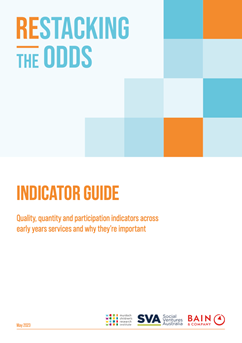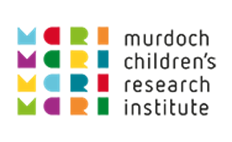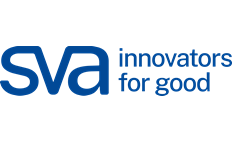RSTO indicators
The Restacking the Odds Indicator Guide: Quality, quantity and participation indicators across early years services and why they’re important
RSTO’s unique approach uses evidence to focus on HOW to work differently to improve outcomes for children, families and communities. It aims to develop the skills and knowledge of service providers and community-based early years initiatives for collecting, understanding and using evidence-based lead indicators to enhance service quality, quantity and participation.
What are lead indicators?
Lead indicators provide information essential to knowing whether you are on track to achieve your goals/ outcomes. They allow service providers and other stakeholders to regularly assess performance and progress, and course correct when required. They reveal what families and children are experiencing, allow service providers, government (local, state, federal) and communities to learn and adjust regularly, rather than waiting for years to see outcomes.
With this information service providers, community initiatives and government policymakers can then identify approaches to address key service gaps for more effective and equitable service delivery.
RSTO Indicator Guide
Access the RSTO Indicator Guide
The RSTO Indicator Guide provides a collection of evidence-based lead indicators for five key early childhood services: antenatal care, nurse home visiting, early childhood education and care, parenting programs and the early years of school (P-3). It is designed for use by:
- local community organisations
- government staff e.g. funders of services across the early years and policy advisors
- service providers
- measurement and evaluation specialists
- researchers.
The framework of lead indicators can be used to:
- better measure service performance and provide more effective and efficient services (and avoid wasting time, money and effort on approaches that fail to deliver results)
- better respond to the needs of children and families in their community, especially those experiencing vulnerability and disadvantage
- learn and share with others striving to improve children’s outcomes
- capture evidence for insights, innovation and advocacy.
Communication summaries
The communication summaries provide an overview of the lead indicators identified for five key services available in most communities: antenatal care, sustained nurse home visiting, early childhood education and care, targeted parenting programs and the early years of school.
Technical reports
RSTO undertook a rigorous research process to identify key lead indicators to guide evidence-based decision-making around service quality, quality, and participation. The technical reports supplement the communication summaries by providing a detailed account of the reviewed literature that informed the development of best practice indicators for antenatal care, early childhood education and care, and parenting programs and Sustained nurse home visiting.
Restacking the Odds is a collaboration between the Centre for Community Child Health at the Murdoch Children's Research Institute, Bain & Company and Social Ventures Australia.
RSTO would like to acknowledge the support of project partners the Minderoo Foundation, Paul Ramsay Foundation and PALO IT.
We acknowledge the Traditional Owners of the land on which we work and pay our respect to Elders past, present and emerging.





